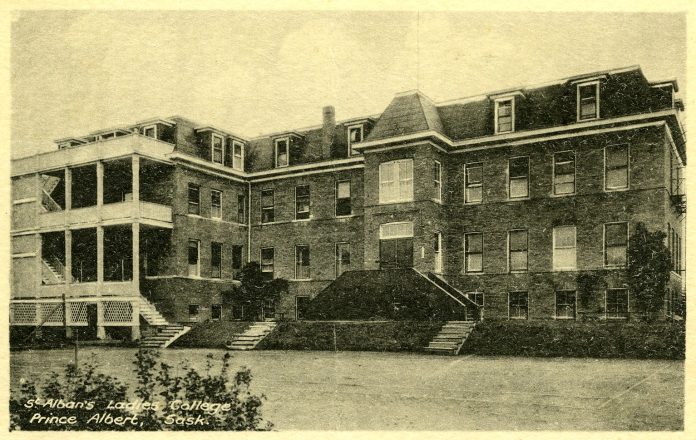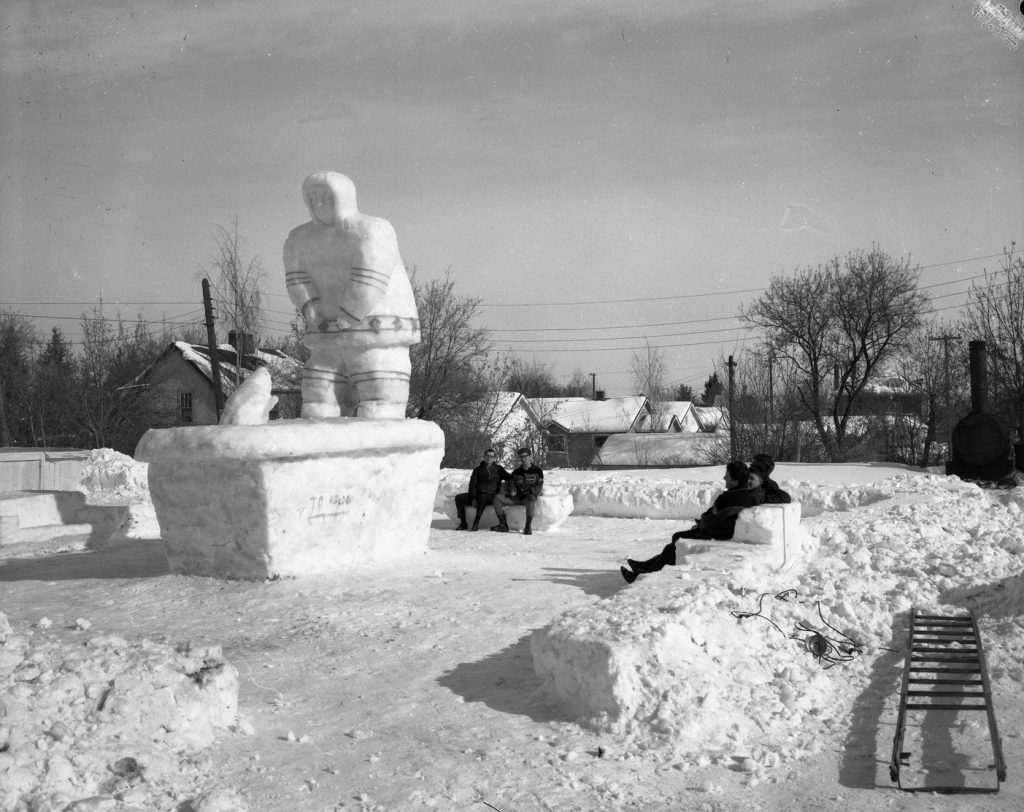
Museum Musings
St. Alban’s Girls College and Notre Dame College
My friend Larry from up Second Avenue called the other day. Both of us having grown up on the West Hill, he was wondering if I had ever considered writing a column on Notre Dame College. Larry remembered having walked past Notre Dame on his way to Pat’s Place and, especially, he recalled the ice sculptures they used to build in the winter time.
Coincidentally, a short time after Larry’s call, Roger St. Pierre called me. Roger tried to teach me French when I was in High School and, regardless of my lack of proficiency in Canada’s other official language, we have continued to have a good relationship. Roger and I have talked about Prince Albert’s past, and I knew that he was well able to recall the days when Notre Dame stood proudly on the hill just across Central Avenue from PACI. It seemed serendipitous, and I decided then and there that I would make Larry happy and write the column he was hoping that I would write.
Roger’s first response to my question about Notre Dame was to ask me if I knew the background to the College. I was aware of the building’s origins, but I also knew that there was a lot of history between 1908, when it first opened as St. Alban’s Girls College, and when it became Notre Dame College. The information which he provided was certainly something of which I was unaware.
Letitia Newnham, wife of the third bishop of the Anglican Diocese of Saskatchewan, was the driving force behind the establishment of St. Alban’s Girls College (often referred to as St. Alban’s Girls School). The Newnhams had daughters whom they wished to receive what was considered to be a “proper education”, and she was convinced that there were other families who had the same desire. The aim of the College was to give the girls “a thoroughly sound and modern education based on religious teaching.” Although founded on the principles of the Church of England, special arrangements were made for girls of other denominations. The curriculum included the regular subjects to meet the requirements of Junior and Senior matriculation examinations supplemented by music, art, and sewing. Part of the recreational activity were focussed on the social graces, such as dancing. Up to 68 young ladies of many denominations were in attendance at the school at one time.
It is likely that the College would have prospered had the owners been more cautious in their plans. Although the name of the school was that of the Anglican cathedral in the city, originally neither the congregation nor the Anglican diocese had any ownership of it. It was, instead, owned by a company which was made up of a number of leading members of the Anglican community, as well as a few other local notables including A.C. Howard.
The company were encouraged by the number of young ladies who were enrolled in the College and, as a result, had a local architect, Danish-born Oluf Albrechtsen, design an addition which was built in 1913. The cost of this addition, at a time when the local economy was about to hit a downturn, resulted in a precarious financial situation. Families who had enrolled their daughters found they either would have to withdraw them or forego the payment of their tuition.
The situation became so tenuous that by the end of 1924, the company which owned the College entered into an agreement with the Diocese wherein the Executive Committee of the Diocese would lease the building for a period of five years, after which they would have an option of renewal. The situation did not improve over that time period and, with the refusal of the City of Prince Albert to waive the taxes on the College, it was decided that in December 1930 to transfer the facility to Saskatoon. The result left the Diocese of Saskatchewan with the building, its maintenance, and the taxes.
Initially, a decision was made to utilise the building as a residence for a training programme referred to as Bishop’s College. This programme had been implemented to replace Emmanuel College within the Diocese. Individuals from local communities within the Diocese who were interested in gaining their theological training would take classes in the city, then participate in a parish to get practical experience prior to returning to the college to take further classwork. A total of 38 men were involved in the programme shortly after St. Alban’s Girls College was transferred to Saskatoon.
This, of course, left considerable space in the building located on the east side of Central Avenue between 20th and 21st Streets. As a result, boys who were residing at St. George’s College (in the upper levels of the Diocesan Synod Office on Second Avenue West) were relocated to the building. Even with this use of the building, there was still a drain on Diocesan resources which needed to be addressed.
In August 1939, an answer seemed to have arrived. The congregation of the Evangelical Church, represented by E.R. Reierson of Minneapolis, and C.D. Sundbo of Weldon, met with the Diocese and offered to purchase the building for use as the Prince Albert Bible Institute and Seminary. The Diocese was able to pay off the taxes owed to the City, and it appeared that the structure would no longer be a liability. Unfortunately, the agreement eventually fell through. At a meeting on Mar. 26, 1942, Mr. Reierson addressed the meeting and was unable to give any assurance that the Evangelical Church would be able to complete the agreement which had been reached in 1939. He did, however, guarantee that all accounts would be met by his group, and allowed that they would not hinder in any way the Diocese should they be able to sell the property to some other agency or organisation. Judge Algernon Doak and Mr. J. Daisley moved that the Diocese should accept the quit claim clearing the property of all encumbrances, with an additional motion from Judge Doak and Arnold Agnew that the trustees of the Prince Albert Bible Institute and Seminary sign a letter undertaking to indemnify the Diocese against any claims put against the building by reason of repair. Both motions were carried.
The Diocesan Executive Committee was once again responsible for the structure first known as St. Alban’s Girls College, and now known as St. George’s Boys College.
A number of options were pursued, including the sale of the land and building to the local Collegiate Board. It even made representation to the federal government use the building as a student residence for First Nation students, arguing that there were sufficient First Nations communities in the Prince Albert region and that students from these communities would be much closer to home were they to attend school locally, rather than in other communities further away, such as Onion Lake and Lac la Ronge. However, the Diocese had no success until fires destroyed the Lac la Ronge student residence in 1947. Suddenly the Prince Albert building was deemed by the federal government to be a useful asset, and a lease agreement was entered into between the Diocese and Ottawa.
When the Onion Lake residential school burned down in 1950, the students from there were also transferred to Prince Albert. They were housed in the former army barracks on the city’s west side. Now, over 350 First Nation students were being housed locally. By 1952, the two schools were amalgamated in that location, and again the property on Central Avenue sat empty.
Another sale of the property was about to occur. An enterprising family from St. Boniface, Manitoba, the Banvilles, were considering the purchase of the property in which they would establish an hotel. A good Roman Catholic family, they paid a visit to the Bishop of Prince Albert, Bishop Blais, and explained to him what they had planned. At the time, no high school for Roman Catholic boys was available with the exception of an English language programme operating in a few rooms in St. Paul’s elementary school and a few classrooms which had been in existence since 1949 at Sion Academy for French language schooling. Provided with the information that the property was for sale, Bishop Blais suggested that it would be perfect for the establishment of a proper French language boys high school.

Residents admire an ice sculpture outside Notre Dame College in this photo from Feb. 24, 1966.
It is unclear whether the Banville family bought the property from the Anglican diocese and either gifted it, or sold it, to the Roman Catholic diocese, or if they withdrew from their option and allowed the Roman Catholic to purchase it. Regardless, the property changed hands from the Anglicans to the Roman Catholics. The building was listed in 1954 as the College de Notre Dame, located on Central Avenue across from PACI, and described as “a boys’ French high school, grades nine to twelve.
My friend Larry remembers the ice sculptures. I remember the hockey rink (which stood where the Girls College had had tennis courts). It was on that ice where I met Jacques Plante, goaltender for the Montreal Canadiens. He was a cousin of Father Jacques Plante, who was a member of the College staff from 1958 to 1961. The goaltender would visit the priest, sometimes accompanied by other members of the team.
In 1967, the local college closed and moved to a new facility in St. Louis, Saskatchewan. By 1968, the property was under development, and in 1969 the apartments of Princeton Place were occupied.
fgpayton@sasktel.net

